Every year since 1975, the organizing committee picks a Sunday in spring and announces the date of the next edition of the Vogalonga, or “long row.” When we heard it was going to be May 31 this year, the first thing most of us thought was “Saharan sun-scorch.” None of us thought “Arctic gale winds,” at least not until we looked out the window that morning.
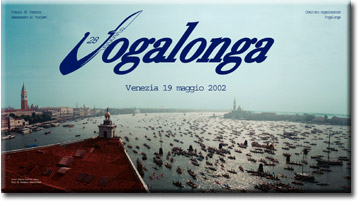
What it is:
- A 30-km (18 miles) course around the islands of the northern lagoon, beginning and starting in the bacino of San Marco, open to any boat propelled by oars.
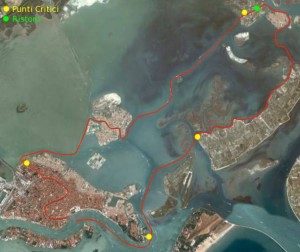
- A chance for people to get down and party, before and after, and occasionally also during.
What it isn’t:
- A race. It starts at 9:00 AM with a blast from the cannon on the island of San Giorgio and a glorious ringing of major church bells. It ends when you return to your base camp, wherever you’ve organized it. The reviewing stand at the mouth of the Grand Canal, where your diploma of participation and medal get thrown into your boat, closes at 2:30. But as far as anybody’s concerned, you can get home long after lights-out.
- A protest against anything. A foundation-myth has been created over the years, for reasons having more to do with local politics than anything else, that this amateur non-competitive marathon is a protest against the “motondoso,” the infamous wave damage which is destroying the city. Motondoso is a fatal phenomenon which Venetians call the “cancer of Venice” and deserves, more than to be protested against, to be resolved once and for all.
The reason it makes no sense to promote this event as a protest is because:
- Each year of the past 35, the motondoso has increased exponentially. If a once-a-year Sunday morning mega-row is supposed to convey serious dissension, something isn’t working.
- By now, the number of participating Venetians has shrunk from 99.9% of the total rowers to about 20%. Or, of some 1,600 boats, only around 300 were Venetian; the rest come from everywhere else — the US, Canada, Russia, Australia, all of Europe, even the Comoro Islands.
- The Venetians already know everything they need to know about motondoso, including the futility of protesting it, either with oars or guns (though guns haven’t yet been tried. Hm…).
- The non-Venetians also have no power to affect anything that happens in Venice, except perhaps the quantity or quality of the garbage they may or may not leave behind. Other than that, it’s pretty clear that if the city government can plug its ears and sing LA-LA-LA-LA when its voting citizens speak up, it’s not going to change everything when a batch of Hungarians or Poles or Kiwis or Comorians lodges a complaint. Which they wouldn’t anyway, because unless some feral taxi should capsize them, they’re probably not going to be too bothered about waves, because motorboats are forbidden along the course. So the rowers have very little chance to experience the glories of motondoso in any case.
One other thing: I’ve experienced a few protests over time, events involving mounted policemen and tear gas and so on. I don’t remember there being people laughing and waving to their friends and taking each other’s pictures and drinking beer. Call it whatever you like; the Vogalonga is essentially one big party, and two large objects like parties and protests just can’t occupy the same space. So much for the protest theory.
We were there this year rowing “San Marco,” the club’s 8-oar gondola. And I’m pretty sure that like everyone else out there when the starting cannon fired at 9:00 AM, we were all thinking, in our various ways, “ohgodohgodohgod.”
Lino admitted when it was all over that he’d had the tiniest hint of a second thought as we started out, but he’s done all 34 and he was determined to make it through the 35th. There aren’t many left who can make that claim, and he was going to do it unless, you know, sheer survival were to become an issue. Not too bad, when you consider that within the space of five months, he’s had a new hip and a pacemaker installed. And that two of the boys aboard had rowed only twice. Ever.
A tremendous wind was blowing, the implacable northeastern blast called the bora, and there were gusts up to 50 miles an hour. Also, the tide was going out, which meant that naturally everyone had to row against it, too. Wind and tide. And it was cold. I’m telling you.
It took us seven hours to finish what normally would have taken four (well, five), but at least we didn’t run into anybody or anything, like channel-marker pilings, though we came close a few times, and we didn’t capsize, which is more than some 30 other boats could claim. The assistance teams stationed around the course had to call for reinforcements to pull people and assorted hulls and oars out of the water.
But we did it, due mainly to Lino, not only because of his strength but even more because of his experience and savvy (“You don’t row with your arms,” he says, “you row with your brain.” The proof of this was seeing the consequences to rowers who didn’t think of how to find some way to make their life out there at least slightly easier, looking for positions that would be more sheltered from the wind, or where the tide would be less strong).
But even with his experience and grit, we, like everybody else out there, had to put everything into it. The wind just never let up, though occasionally it would hurl itself against the right side of the boat, which would slew to the right, so I had to exert a sudden powerful counterstroke to keep the boat from slewing around to the right, usually in front of an onrushing cavalcade of hapless rowers. Lino, astern, exerted his own counterstroke whenever the wind shifted to the left side of the boat. the same when the wind shifted. The others just kept rowing along, like the slaves below decks in Ben-Hur.
But we all had confidence in him, which was the real secret to it all. I can say that because another boat from our club turned back. It wasn’t that they couldn’t do it physically; they had no confidence. Mental, not muscles. I want you to remember that — it’s another of those crucial Life Lessons you pick up in a boat. I have quite a list by now.
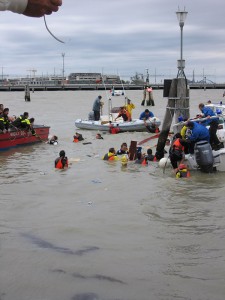
About those capsized boats. Some accounts make it sound as if the entire course was like the Spanish Armada being blown around England. In fact, the accidents were pretty much limited to a particular category in a particular location:
- Low slim sculls of various-size crews. Not really built for the high seas, as it were; not especially capable of having the last word in an argument with waves.
- The entrance to the Cannaregio Canal, where the rowers enter Venice and head into the Grand Canal and down to the finish line.
- This was the most hazardous place for sculls because it was full of large, heavy, following waves caused by the particular behavior of the tides at that point. And because….
- Many rowers didn’t calculate for the rebound of the waves from the nearby embankment. They might have managed to surf along atop one set of inbound waves, but couldn’t deal with the busted-up remains of the same waves coming back at them.
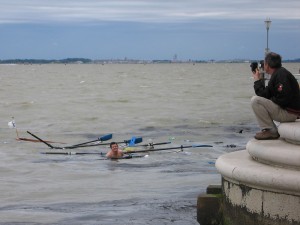
Knowledgeable, or cautious, rowers tended to swing wide before positioning themselves for entry into the canal, thereby avoiding the worst.
I’m explaining all this because you never know when it might be useful to know this.
I took several aspirin and was in bed before 9:00 that night. My last thought was wondering which parts of my body were going to hurt the most the next morning.
Surprisingly, very few. Almost none, really, except for a lovely pair of screaming matched trapezius muscles. And my hands, which felt like lobster claws. Gripping an oar, exerting about a thousand pounds-force per square inch on a stick of wood for much of seven hours, has quite an effect on the old mitts. All those years of piano lessons? No more hope of Rachmaninoff for me.
What really astonishes me is my capacity to remember events like this with something like pleasure. Must be hormones or something, the euphoria of survival. The traps have stopped crying, the hands are back at the keyboard, and I’d say I’m almost ready to do it all again. Like so many things in Erlaworld, it makes no sense.
(Below: In the Cannaregio Canal. We’re smiling because the end is in sight, and because finally we’re going with the tide. I’m the waver wearing the red baseball cap. I have no recollection who I’m waving at.)

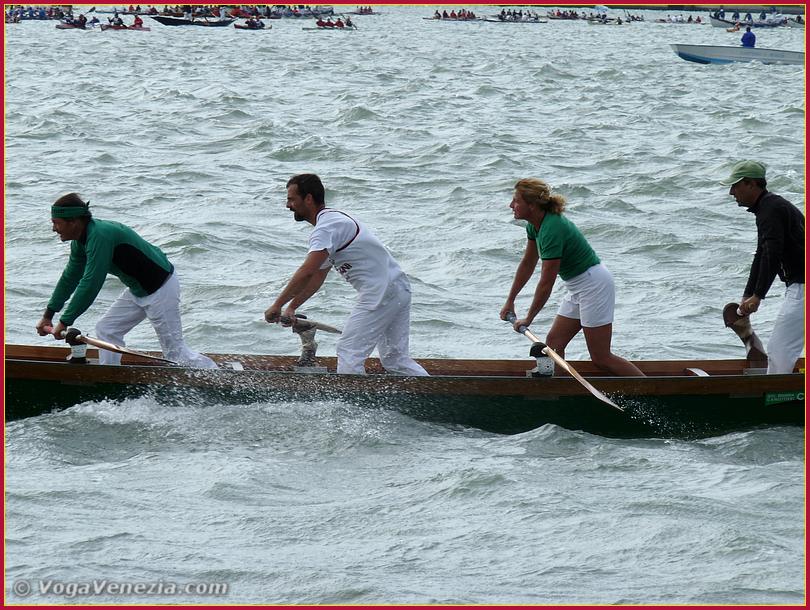
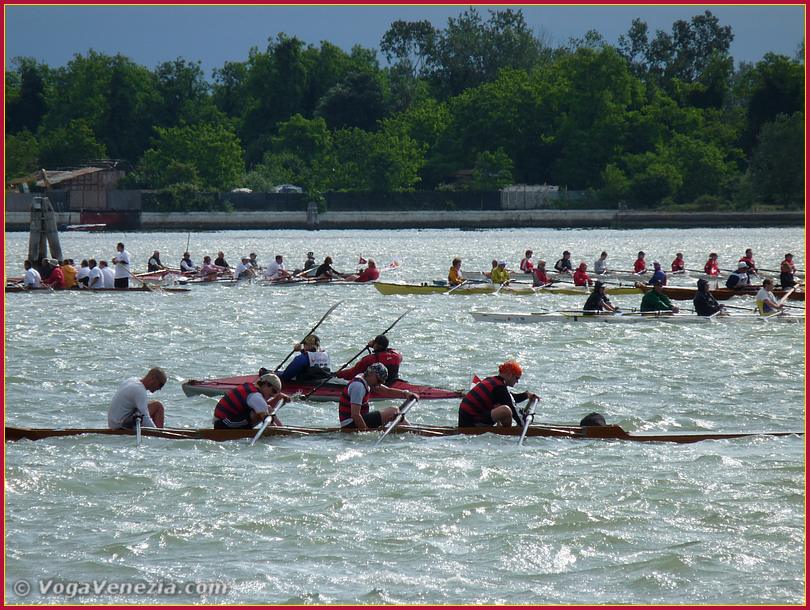

5 Comments
Talk about a tough row to hoe! This was a tough row to row. Wow and gasp!
So just what DID the Zwingle girls eat for breakfast during their formative years?
And there’s that Lino, barefoot and grinning, looking sweetly smug. And all those game-faced unintentional “swimmers,” just slapping the water’s back in what looks to be a hale-fellow-well-met greeting, as if to say: “Well, as long as I have to be freezing-ass cold, exhausted, hyper-extended, wet and embarrassed, there’s no one I’d rather be sharing it with than you, old pal.” These are amazing ways you spend your days, E, and reading about them both uplifts and astonishes a not-too-much-older woman who logs WAAAAaaaaay too many hours these same days, um, studying [yes, that’s it] classic film on TV.
tech wreck
What a wonderful event! This looks like Neal’s cup o’ tea. He prides himself on his rough water moxie and would have streaked past the floundering hoardes with a satisfied smirk! I love the photos and the accounts. It looks like a lot more fun than the grim 32 nautical mile Catalina (CA) Crossing!